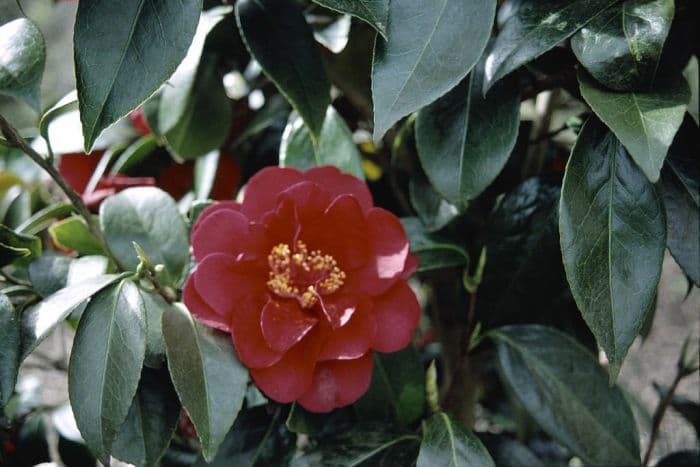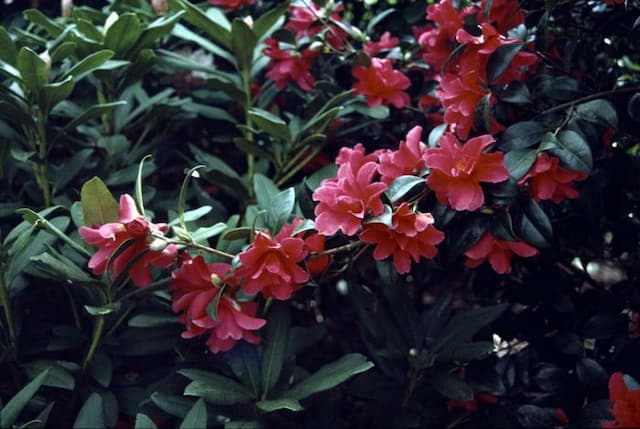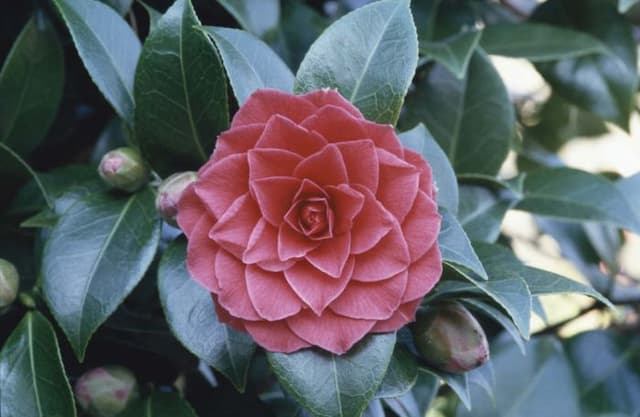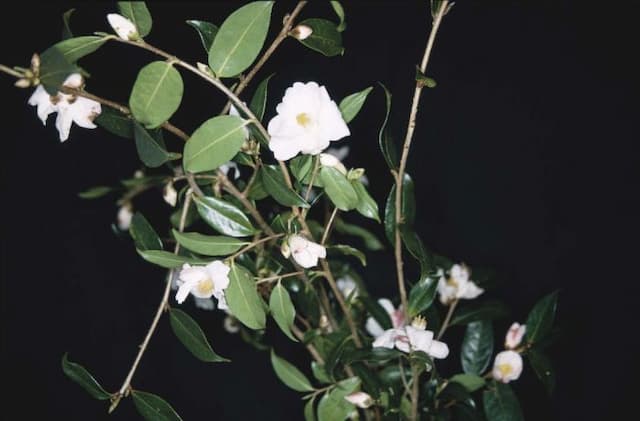Japanese Camellia Camellia japonica 'Bob Hope'

ABOUT
The Camellia japonica 'Bob Hope' is an evergreen shrub renowned for its exquisite flowers and glossy, dark green leaves. The plant boasts large, semi-double to peony-form blooms that exhibit a deep, velvety red color with a mesmerizing sheen. Its petals are beautifully arranged and may occasionally showcase lighter streaks or edges, adding to the flower's dramatic flair. Typically, a cluster of bright yellow stamens emerges from the center of each flower, creating a stunning contrast with the rich red petals. The leaves of 'Bob Hope' are leathery in texture, with a classic oval shape and a slightly serrated edge, which provides a lush backdrop for the plant's showy blossoms. As an ornamental shrub, it carries an air of elegance and is often used in gardens for its decorative appeal throughout the blooming season. The overall impression of Camellia japonica 'Bob Hope' is one of visual impact and sophisticated beauty, making it a beloved choice for garden enthusiasts.
About this plant
 Names
NamesFamily
Theaceae
Synonyms
Japanese Camellia, Rose of Winter
Common names
Camellia japonica 'Bob Hope'.
 Toxicity
ToxicityTo humans
The Japanese camellia is generally considered to be non-toxic to humans. There are no significant symptoms of poisoning associated with this plant, as it is not known to contain harmful substances that lead to toxic reactions upon ingestion. Therefore, it does not pose serious risks if accidentally consumed. However, it is always advisable to keep any non-food plants out of reach of small children who may be inclined to ingest plant material.
To pets
The Japanese camellia is also generally considered to be non-toxic to pets. It does not contain any known toxins that would cause serious harm to dogs, cats, or other domestic animals if they consume parts of the plant. As with humans, no significant symptoms of poisoning are expected. However, ingestion of plant material can sometimes result in mild gastrointestinal upset in pets, such as vomiting or diarrhea, simply due to the ingestion of non-digestible matter. Owners should still prevent pets from eating ornamental plants as a precaution.
 Characteristics
CharacteristicsLife cycle
Perennials
Foliage type
Evergreen
Color of leaves
Green
Flower color
Red
Height
6-10 feet (1.8-3 meters)
Spread
6-10 feet (1.8-3 meters)
Plant type
Shrub
Hardiness zones
7-9
Native area
Japan
Benefits
 General Benefits
General Benefits- Ornamental Appeal: Camellia japonica 'Bob Hope' produces striking, large, deep red flowers that enhance the aesthetic of any garden.
- Year-Round Interest: It has glossy, evergreen foliage that provides visual interest even when the plant is not in bloom.
- Privacy Screen: Can be used as a hedge or screen to provide privacy in a garden or yard due to its dense foliage.
- Habitat for Wildlife: Provides food and shelter for various species of birds and beneficial insects.
- Tolerant of Partial Shade: Adaptable to a range of light conditions, making it suitable for gardens with varying levels of sunlight.
- Soil Adaptability: Capable of growing in a variety of soil types, though it prefers well-draining, acidic soil.
- Low Maintenance: Requires minimal pruning and is relatively low maintenance once established.
- Longevity: Known to be a long-lived plant, which can remain in the same location for many years with proper care.
- Symbolic Significance: In certain cultures, Camellias represent love, devotion, and admiration, adding a layer of meaning to the plant when gifted or grown.
 Medical Properties
Medical PropertiesThis plant is not used for medical purposes.
 Air-purifying Qualities
Air-purifying QualitiesThis plant is not specifically known for air purifying qualities.
 Other Uses
Other Uses- As a natural dye: The petals of Camellia japonica can be used to create delicate pink dyes for fabrics, though not commonly practiced.
- Art and Illustration: Artists sometimes press the flowers of the camellia to use as natural ornaments or inspirations in botanical illustrations.
- Traditional Games: In East Asia, dried camellia petals have been used in traditional games, akin to potpourri toss or as pieces in board games.
- Insect habitat: Camellia bushes provide shelter for various insects, which may be a consideration for gardeners looking to promote local biodiversity.
- Ceremonial decoration: In some cultures, the camellia’s flowers are used to adorn ceremonial venues, such as wedding sites or places of worship, due to their beauty and form.
- Photography subject: Camellia japonica's vibrant flowers make it a popular subject for photographers and nature enthusiasts seeking to capture its seasonal beauty.
- Literary Inspiration: Poets and writers have often used the beauty of the camellia flower as a metaphor or symbol in literature and poetry.
- Culinary Decoration: The petals, though not commonly used due to their lack of flavor, can occasionally be used for garnishing in high-end culinary presentations.
- Flower Language: In the language of flowers, camellia japonica is often used to convey admiration or perfection, making it a thoughtful element in bouquets with a message.
- Crafting and Modelling: The sturdy leaves of the Camellia japonica can be used in crafting, such as for model making or as a durable natural decorative element.
Interesting Facts
 Feng Shui
Feng ShuiThe Camellia is not used in Feng Shui practice.
 Zodiac Sign Compitability
Zodiac Sign CompitabilityThe Camellia is not used in astrology practice.
 Plant Symbolism
Plant Symbolism- Adoration and Devotion: The Camellia often symbolizes deep devotion or adoration towards someone due to its lush, full blooms and long-lasting nature.
- Love and Passion: It denotes deep romantic love and passion, making it an ideal gift for a lover or spouse.
- Perfection and Excellence: Owing to its perfect petals and elegant appearance, the Camellia represents the pursuit of perfection and excellence.
- Longevity and Faithfulness: Its ability to bloom through winter signifies longevity and faithfulness in relationships.
- Refinement and Purity: With its delicate form and pure coloration, the Camellia suggests refinement, pure intentions, and a noble spirit.
 Water
WaterJapanese camellias, including the 'Bob Hope', should be consistently watered to keep the soil moist but not waterlogged. They prefer deep watering, which should be done when the top couple inches of soil feel dry to the touch. Water the plant with approximately 1 to 1.5 gallons every week during the growing season, and reduce watering frequency during the winter when the plant is not actively growing. Avoid overhead watering to prevent leaf and flower diseases, and always use a gentle flow to soak the soil thoroughly without causing erosion.
 Light
LightThe Japanese camellia 'Bob Hope' thrives in partial shade to dappled sunlight conditions. It's best to place it in a location where it's protected from the harsh afternoon sun, but still receives ample morning light or filtered light throughout the day. Avoid exposing the plant to full sun as it can lead to leaf scorch and stress the camellia.
 Temperature
TemperatureThe ideal temperature range for the Japanese camellia 'Bob Hope' is between 60 to 80 degrees Fahrenheit, with a minimum survivable temperature around 20 degrees Fahrenheit. They can tolerate short periods of colder weather but should be protected from frost to prevent damage to flowers and buds. Camellias prefer a consistent and moderate climate without extreme fluctuations in temperature.
 Pruning
PruningPrune the Japanese camellia 'Bob Hope' after it finishes blooming in spring to shape the plant and remove any dead or weak wood. Regular pruning helps encourage new growth and more abundant flowering. Thin out dense branches to improve air circulation, which reduces the risk of disease. Pruning should be done yearly, or as needed, to maintain the desired shape and health of the plant.
 Cleaning
CleaningAs needed
 Soil
SoilThe best soil mix for Japanese camellia 'Bob Hope' should be well-draining with high organic matter. A blend of two parts peat moss or well-rotted pine bark to one part perlite works well. Camellia japonicas prefer a slightly acidic pH of 5.5 to 6.5.
 Repotting
RepottingJapanese camellia 'Bob Hope' typically needs repotting every 2 to 4 years. It is best to repot in the spring before the growing season starts or after flowering.
 Humidity & Misting
Humidity & MistingJapanese camellia 'Bob Hope' thrives at humidity levels between 40% to 60%. They benefit from misting or a humidity tray, particularly in drier indoor environments.
 Suitable locations
Suitable locationsIndoor
Place in bright, indirect light and keep away from drafts.
Outdoor
Plant in partial shade, shelter from strong winds.
Hardiness zone
7-9 USDA
 Life cycle
Life cycleThe life of Camellia japonica 'Bob Hope', commonly known as the 'Bob Hope' Camellia, begins with seed germination in a warm, moist soil environment, typically occurring in late winter or early spring. The seedling stage involves the growth of initial roots and shoots, followed by the development of true leaves as it matures into a young plant. During the vegetative growth stage, the 'Bob Hope' Camellia develops a sturdy stem and a bushy foliage of glossy, dark green leaves, preparing the framework for future flowering. Once mature, the reproductive stage is marked by the production of its renowned large, peony-like flowers, usually a deep red color, which bloom primarily in late winter to spring. After pollination, which can be aided by insects, the plant forms seed pods that eventually mature and open to disperse seeds, perpetuating the life cycle. Throughout its life, the 'Bob Hope' Camellia may undergo periods of dormancy, particularly in colder climates, where growth slows down during the winter months before resuming in the spring.
 Propogation
PropogationPropogation time
Spring-Early Summer
The Camellia japonica 'Bob Hope', commonly known as the Bob Hope camellia, is typically propagated by semi-hardwood cuttings. The best time for propagation is late summer, when the new growth has begun to harden but is not yet fully mature. To propagate, take cuttings about 4 to 6 inches long with several leaves attached. The bottom end of the cutting should be dipped in rooting hormone to increase the chance of successful root development. Afterward, plant the cutting in a well-drained potting mix, ensuring that the soil remains moist but not waterlogged, and provide a warm environment and indirect light. Covering the pot with a plastic bag can help maintain humidity, which is crucial for rooting. It usually takes a few months for the cutting to root sufficiently to be transferred to a larger pot or outdoor location.









